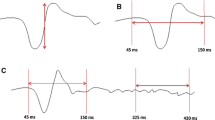Abstract
Principal component analysis (PCA) was employed to enhance the multifocal visual evoked potential (mfVEP) technique. First, by using four principal components, the separation of mfVEP signals from noises was improved. Second, two otherwise unused higher order kernels, the 2nd slice of the 2nd order kernel and the 4th order kernels, were utilized by combining information obtained from the PCA. The PCA-kernel method improves the efficiency of the mfVEP test. The false positive rate, based upon an analysis of a noise window, was decreased by a factor of about one-third and the improvement in sensitivity of detecting glaucomatous defects was nearly as good as a doubling of the recording time.
Similar content being viewed by others
References
Baseler HA, Sutter EE, Klein SA, Carney T. The topog-raphy of visual evoked response properties across the visual eld. Electroencephalogr Clin Neurophysiol 1994; 90(1): 65–81.
Klistorner AI, Graham SL, Grigg JR, Billson FA. Multi-focal topographic visual evoked potential:improving objective detection of local visual eld defects. Invest Ophthalmol Vis Sci 1998; 39(6): 937–50.
Hood DC, Zhang X, Greenstein VC, Kangovi S, Odel JG, Liebmann JM, Ritch R. An interocular comparison of the multifocal VEP:a possible technique for detecting local damage to the optic nerve. Invest Ophthalmol Vis Sci 2000; 41(6): 1580–7.
Hood DC, Odel JG, Zhang X. Tracking the recovery of local optic nerve function after optic neuritis:a multifo-cal VEP study. Invest Ophthalmol Vis Sci 2000; 41(12): 4032–8.
Goldberg I, Graham SL, Klistorner AI. Multifocal objective perimetry in the detection of glaucomatous eld loss. Am J Ophthalmol 2002; 133(1): 29–39.
Hood DC, Greenstein VC. Multifocal VEP and gan-glion cell damage:applications and limitations for the study of glaucoma. Prog Retin Eye Res 2003; 22(2): 201–51.
Hood DC, Zhang X, Winn BJ. Detecting glaucomatous damage with multifocal visual evoked potentials:how can a monocular test work? J Glaucoma 2003; 12(1): 3–15.
Hood DC, Zhang X. Multifocal ERG and VEP responses and visual elds:comparing disease-related changes. Doc Ophthalmol 2000; 100(2 –3): 115–37.
Hood DC, Greenstein VC, Odel JG, Zhang X, Ritch R, Liebmann JM, Hong JE, Chen CS, Thienprasiddhi P. Visual eld defects and multifocal visual evoked poten-tials:evidence of a linear relationship. Arch Ophthalmol 2002; 120(12): 1672–81.
Zhang X, Hood DC, Chen CS, Hong JE. A signal-to-noise analysis of multifocal VEP responses:an objective de nition for poor records. Doc Ophthalmol 2002; 104(3): 287–302.
Sutter EE, Tran D. The eld topography of ERG com-ponents in man –I. The photopic luminance response. Vision Res 1992; 32(3): 433–46.
Baseler HA, Sutter EE. M and P components of the VEP and their visual eld distribution. Vision Res 1997; 37(6): 675–90.
Slotnick SD, Klein SA, Carney T, Sutter E, Dastmalchi S. Using multi-stimulus VEP source localization to obtain a retinotopic map of human primary visual cortex. Clin Neurophysiol 1999; 110(10): 1793–800.
James AC. The pattern-pulse multifocal visual evoked potential. Invest Ophthalmol Vis Sci 2003; 44(2): 879–90.
Zhang X, Hood DC. A principal component analysis of multifocal VEP. Vision, in press. 16. Hood DC. Assessing retinal function with the multifocal technique. Prog Retin Eye Res 2000; 19(5): 607–46.
Sutter EE. Imaging visual function with the multifocal m-sequence technique. Vision Res 2001; 41(10 –11): 1241–55.
Horton JC, Hoyt WF. The representation of the visual eld in human striate cortex. A revision of the classic Holmes map. Arch Ophthalmol 1991; 109(6): 816–24.
Hood DC, Thienprasiddhi P, Greenstein VC, Winn BJ, Ohri N, Liebmann JM et al. Detecting early to mild glaucomatous damage:a comparison of the multifocal VEP and automated perimetry. Invest Ophthalmol Vis Sci, 2004; 45(2): 492–498.
Hood DC, Zhang X, Hong JE, Chen CS. Quantifying the bene ts of additional channels of multifocal VEP recording. Doc Ophthalmol 2002; 104(3): 303–20.
Hood DC, Zhang X, Ohri N, Thienprasiddhi P, Xu L, Liebmann JM. Possible indices for minimizing false posi-tives on the multifocal VEP test. ARVO Abstract, 2004; 3302.
Author information
Authors and Affiliations
Rights and permissions
About this article
Cite this article
Zhang, X., Hood, D. Increasing the sensitivity of the multifocal visual evoked potential (mfVEP) technique: incorporating information from higher order kernels using a principal component analysis method. Doc Ophthalmol 108, 211–222 (2004). https://doi.org/10.1007/s10633-004-5323-3
Issue Date:
DOI: https://doi.org/10.1007/s10633-004-5323-3




